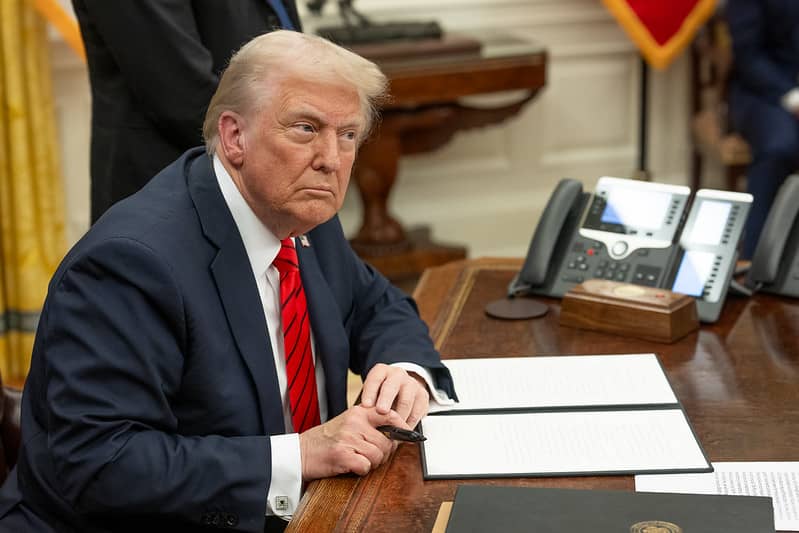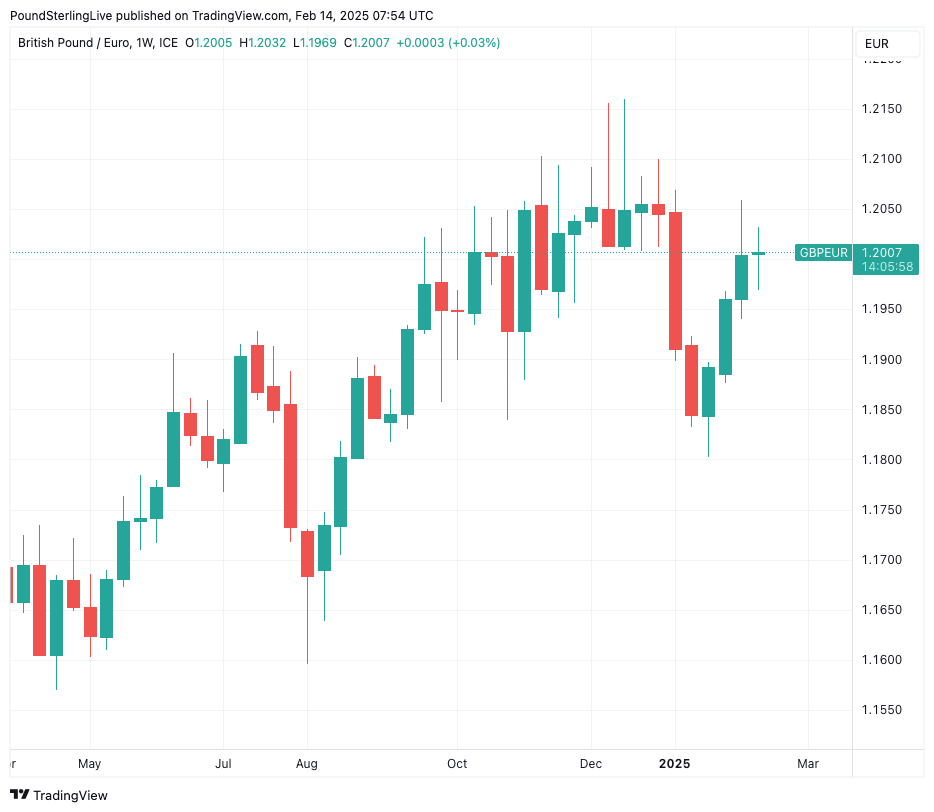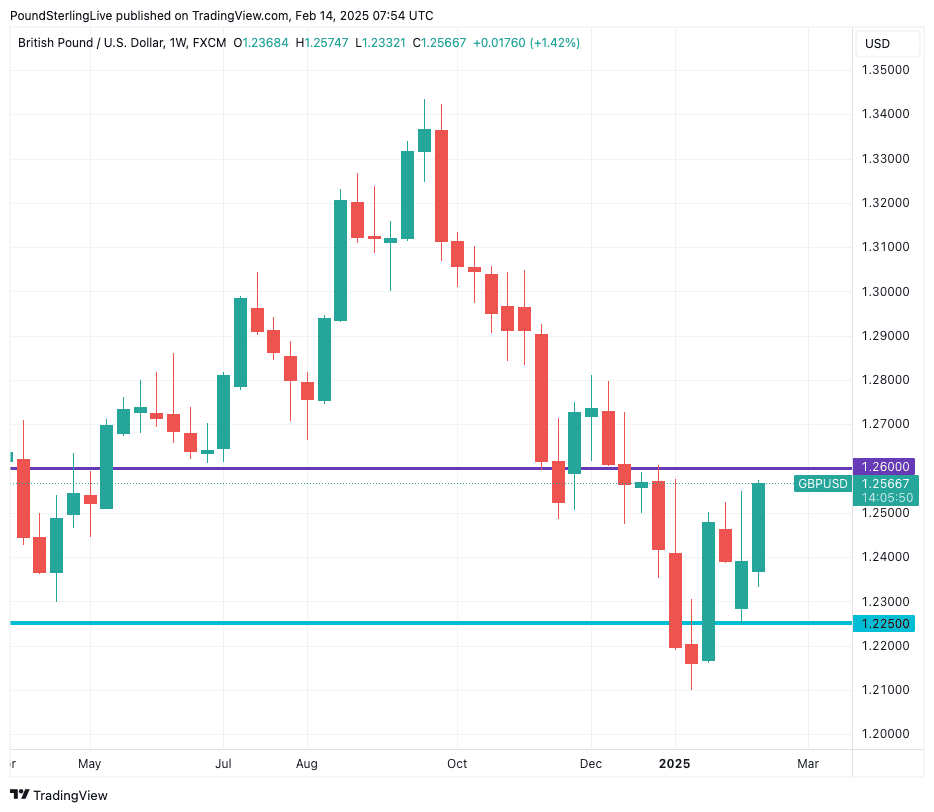
Image: Official White House photo by Daniel Torok.
The British Pound brushed aside threats by U.S. President Donald Trump to tariff countries for charging VAT and looks set to record another weekly gain against the Dollar and Euro.
On Thursday, Trump detailed plans to charge "reciprocal" tariffs on goods from those countries that tariff the U.S. from as soon as April.
However, the President surprised observers by saying he would tariff countries that charge sales taxes like VAT, which would include the UK.
The notion that VAT is a tariff is absurd and confirms an agenda that penalises everyone, whether an ally or foe, to raise revenues for the U.S. The scattergun approach creates significant uncertainty for financial markets as it becomes difficult to predict where tariffs will fall and to what extent. It makes it hard for other countries to respond.
"If Thursday was the 'Big Day' for US reciprocal tariffs, you wouldn't have known it by looking at the global equity rally or the slightly softer dollar. The benign impact on markets of yesterday's tariff
announcement owes largely to the tariff measures being incredibly complex and not coming in until after April - allowing plenty of time for negotiation," says Chris Turner, Global Head of Markets at ING.
It's becoming clearer that foreign exchange markets are rapidly losing interest: the Dollar is down a per cent this week and heading for its fourth weekly decline of 2025.
"The law of diminishing returns seems to be in play as tariff-related headlines seem less provocative for the FX market," says Daragh Maher, a currency strategist at HSBC.
A Tariff for Your VAT
Pound Sterling Live wrote on Wednesday that Pound Sterling faces the risk of an expanded U.S. tariff regime that aims to address stifling corporate rules impacting U.S. companies.
We reported that Howard Lutnick, the incoming U.S. commerce secretary, would seek to impose tariffs on countries that had onerous environmental, social and governance (ESG) rules, which he says penalises American companies.
Now, Trump thinks VAT also punishes American companies. "We're going to call it a tariff," he told reporters in the White House.
The UK had imposed VAT since 1973 when it joined what would later become the European Union.
The U.S. vowed to address "each country one by one. In almost all cases, they're charging us vastly more than we charge them but those days are over."
The U.S.-based Tax Foundation, a right-leaning think tank, said on Thursday that VAT "is not a tariff" and is "trade neutral".
"Historical evidence and recent studies show that tariffs are taxes that raise prices and reduce available quantities of goods and services for US businesses and consumers, which results in lower income, reduced employment, and lower economic output," it explains.
Trump says his reciprocal tariffs will aim to rebalance global trade dynamics in favour of the U.S. Analysts point out Britain already has a balanced trade in goods with the U.S., which would technically lead Trump to see the UK as a low-priority target.
But targeting VAT says it's not about global trade but rather the exercise of American economic power and raising revenues.
On this basis, the UK won't escape by virtue of its favourable trade balance.
Above: GBPEUR is aiming for another weekly gain.
UK's Digital Tax to Draw Trump's Ire
Although the UK charges VAT, it should be clear enough that it is a non-discriminatory tax that all companies pay.
This means Trump will almost certainly look elsewhere, which brings the UK's Digital Service Tax (DST) into scope. The tax takes aim at U.S. tech giants and seeks to make them pay more taxes on their considerable UK-based earnings instead of just shipping UK tax liabilities to places like Ireland via clever accounting.
The UK can make it clear to the President that U.S. companies are treating the UK "very badly," to quote one of Trump's favourite lines.
In 2023, the UK's HMRC said U.S. companies underpaid £5.6BN in UK tax, up 14% in a year, highlighting the scale of the problem facing the UK.
A UK threat to raise this tax would represent a countermeasure to Trump's tariffs and help the UK negotiate a lower tariff rate.
Above: GBPUSD could soon take out 1.26.
Impact on the Pound
The foreign exchange market response was not just benign; it was outright USD-bearish, which suggests the relationship between the dollar and tariff threats has evaporated.
One explanation for these moves is that the tariffs would only come into place in April, which gives ample opportunity for the UK to negotiate on the issue.
This week, we saw Australia dodge the universal tariff on aluminium and steel imports following a phone call between Trump and Australian Prime Minister Anthony Albanese.
Markets now know the worst-case scenarios are avoidable and are unwinding USD tariff premiums.
The Pound-to-Dollar exchange rate has entered a short-term recovery sequence, and it looks as though this can continue, with the big number at 1.26 now easily in scope.
The Pound-to-Euro exchange rate is meanwhile showing limited volatility around the 1.20 area, and we note the pair has been stuck in a tight sideways-moving range for a week now.
"The dollar has weakened on talks of an end to the Ukraine war, to new year-to-date highs towards 1.2600, while GBP/EUR continues to pivot around 1.2000 on generally lower liquidity," says a note from Arbuthnot Latham.
Tariffs will inevitably hurt the Eurozone more than the UK because of the significant trade surplus in goods European countries maintain with the U.S.
This can underpin Pound-Euro going forward to the extent that tariffs are still a major concern for FX markets.


